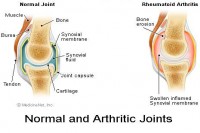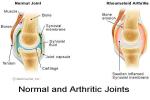The following are some key facts about arthritis:
What is Arthritis?
Simply put, arthritis is inflammation in the joint. Though many times the word arthritis is used as if it is one disease, there are over 100 types of arthritis that have been identified to date[1]. The most common types of arthritis are osteoarthritis (OA), rheumatoid arthritis (RA) and gout. There are over 46 million Americans who have been diagnosed with some form of arthritis[2].
What are the signs and symptoms?
The most common signs or symptoms are joint pain, stiffness and inflammation. Depending on the arthritis type, a person could experience these symptoms in the following areas: wrists, fingers, knees, ankles, toes, hips, shoulders and elbows.
What is the difference between osteoarthritis and rheumatoid arthritis?
These two types of arthritis are the most common types.
- Osteoarthritis is a condition that occurs when the joint cartilage breaks down. The cartilage is the smooth, tissue that covers the ends of the bones where they meet, preventing them from rubbing each other. Osteoarthritis is the most prevalent form of arthritis, and usually effects people over age 45.
- Rheumatoid Arthritis is an inflammatory disease in which the body’s immune system attacks its own healthy tissues. RA can affect anyone at any age.
What is gout?
Gout occurs when there is a buildup of uric acid, a waste product of the urine cycle, which deposits razor-sharp crystals in the joint spaces between bones[3].
What tests can be performed to diagnose arthritis?
There is not just one test to diagnose arthritis. Depending on your health care provider and the patient’s symptoms the tests will vary. For instance, conventional medical physicians tend to start with blood tests and X-rays. On the other hand, alternative holistic physicians tend to do a variety of tests understand the cause, some of which include, allergy tests, hormone tests, digestive function tests, tests for parasites, and heavy metal toxicity.[4]
What causes arthritis?
The causes will vary depending on the type of arthritis. For osteoarthritis, some of the causes occurs from wear and tear on the joints over one’s lifetime, obesity, hormone imbalance, or food allergies. On the other hand for rheumatoid arthritis, some of the causes that drive inflammation include, but not limited to food allergies, toxicity, nutritional deficiencies, intestinal permeability and microorganisms.
How can arthritis be treated?
Depending on the type of arthritis, the treatment plan will vary. Conventional treatments (ordered by traditional medical physician) tend to start with NSAIDs (Non-steriodal anti-inflammatory drugs) such as ibuprofen (Motrin) or naproxen (Aleeve) and then transitions to a treatment that include COX-2 inhibitors such as Vioxx, Celebrex or Enbrel. Many of these conventional drugs have been known to increase the risk of heart attacks and sudden cardiac death! Sometimes if NSAIDs aren’t effective, some patients turn to injections of cortisone (corticosteroids) or methotrexate.
Are there any alternative treatment therapies for arthritis?
There are a number of treatment options such as dietary changes (food, vitamin supplements), detoxification, exercise, and stress reduction. However, food is a major factor in triggering inflammation in the joints and by reducing one’s daily intake of foods that are pro-inflammatory, can minimize and stop the pain! To see a list of foods that trigger inflammation, click here.
Even if you do not have arthritis, do your part in raising awareness about arthritis and share this with your loved ones and your social network! Don’t forget to download the Tip Share app!
Sources:
[1][3][4]Kamhi, Ellen and Zampieron, Eugene. Arthritis. Celestial Arts: California, 2006.
[2]”Link Between Arthritis and Heart Disease.” Arthritis Foundation. http://www.arthritis.org/heart-disease-connection.php


